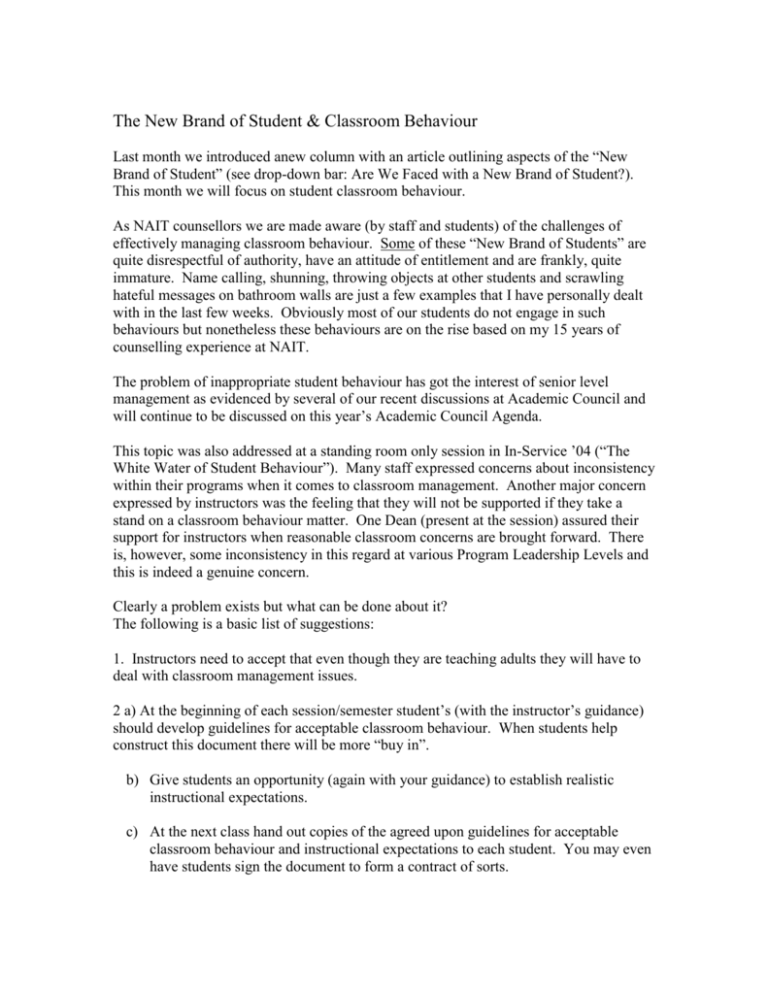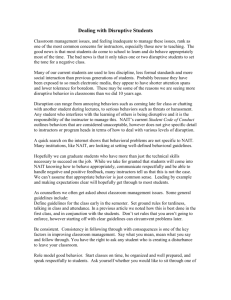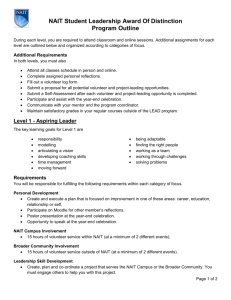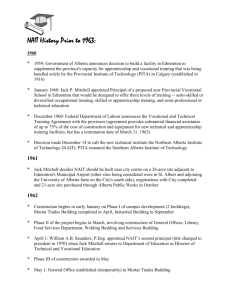The New Brand of Student &Classroom Behavior
advertisement

The New Brand of Student & Classroom Behaviour Last month we introduced anew column with an article outlining aspects of the “New Brand of Student” (see drop-down bar: Are We Faced with a New Brand of Student?). This month we will focus on student classroom behaviour. As NAIT counsellors we are made aware (by staff and students) of the challenges of effectively managing classroom behaviour. Some of these “New Brand of Students” are quite disrespectful of authority, have an attitude of entitlement and are frankly, quite immature. Name calling, shunning, throwing objects at other students and scrawling hateful messages on bathroom walls are just a few examples that I have personally dealt with in the last few weeks. Obviously most of our students do not engage in such behaviours but nonetheless these behaviours are on the rise based on my 15 years of counselling experience at NAIT. The problem of inappropriate student behaviour has got the interest of senior level management as evidenced by several of our recent discussions at Academic Council and will continue to be discussed on this year’s Academic Council Agenda. This topic was also addressed at a standing room only session in In-Service ’04 (“The White Water of Student Behaviour”). Many staff expressed concerns about inconsistency within their programs when it comes to classroom management. Another major concern expressed by instructors was the feeling that they will not be supported if they take a stand on a classroom behaviour matter. One Dean (present at the session) assured their support for instructors when reasonable classroom concerns are brought forward. There is, however, some inconsistency in this regard at various Program Leadership Levels and this is indeed a genuine concern. Clearly a problem exists but what can be done about it? The following is a basic list of suggestions: 1. Instructors need to accept that even though they are teaching adults they will have to deal with classroom management issues. 2 a) At the beginning of each session/semester student’s (with the instructor’s guidance) should develop guidelines for acceptable classroom behaviour. When students help construct this document there will be more “buy in”. b) Give students an opportunity (again with your guidance) to establish realistic instructional expectations. c) At the next class hand out copies of the agreed upon guidelines for acceptable classroom behaviour and instructional expectations to each student. You may even have students sign the document to form a contract of sorts. Note: These first three actions help foster an environment of mutual respect and rapport and help create an environment conducive to learning. 3. Indicate that NAIT has Student Conduct sections in the Academic Regulations and that most of that section is covered in the NAIT Students’ Day Planner. Consider reviewing or highlighting these documents. 4. Lead by example. Be mindful of how you treat your students. What do you say? How do you say it? Are you respectful of them? Do you come to class on time and well prepared? Remember that you set the tone for your classroom. An enthusiastic approach to your teaching will go a long way to minimizing classroom management problems as will a variety of effective teaching strategies (including a more interactive approach). 5. Do not allow disruptive behaviour to continue. After a single warning, ask a disruptive student to leave. Make it clear that you will not tolerate behaviour that disrupts your teaching or other’s learning. 6. Refer “repeat offenders” to Program Leaders. 7. Program Leaders need to support instructors when disciplinary issues are brought to their attention. It is imperative that instructors know that they will get this support consistently (when warranted). 8. a) Program Leaders need to be prepared to put students on academic probation and/or behavioural contracts. Seeing a NAIT counsellor may become a condition within such a contract. b) Program Leaders need to be prepared to recommend student expulsion to their Dean when students violate the terms of their academic probation/behavioural contract. 9. Make the distinction clear in your own mind between being friendly and being the student’s friend. The latter is inappropriate. 10. Solicit the help of a NAIT Counsellor. Students tell us that they want structure/boundaries and are very frustrated when classroom management is inadequately handled. Every learner and instructor has the right to learn/teach in an environment that is conducive to learning. You set the tone for behaviour in your class. You are in control. You will be supported by Program Leadership. Let’s make a commitment to raising the standard of student (and in some cases staff) behaviour at NAIT. We welcome your feedback. Please advise us if we can assist you as we collectively work toward the goal of student success. (article by David Appell as printed in the NASA Intercom, Nov. 2004. David can be contacted at dappell@nait.ca)








